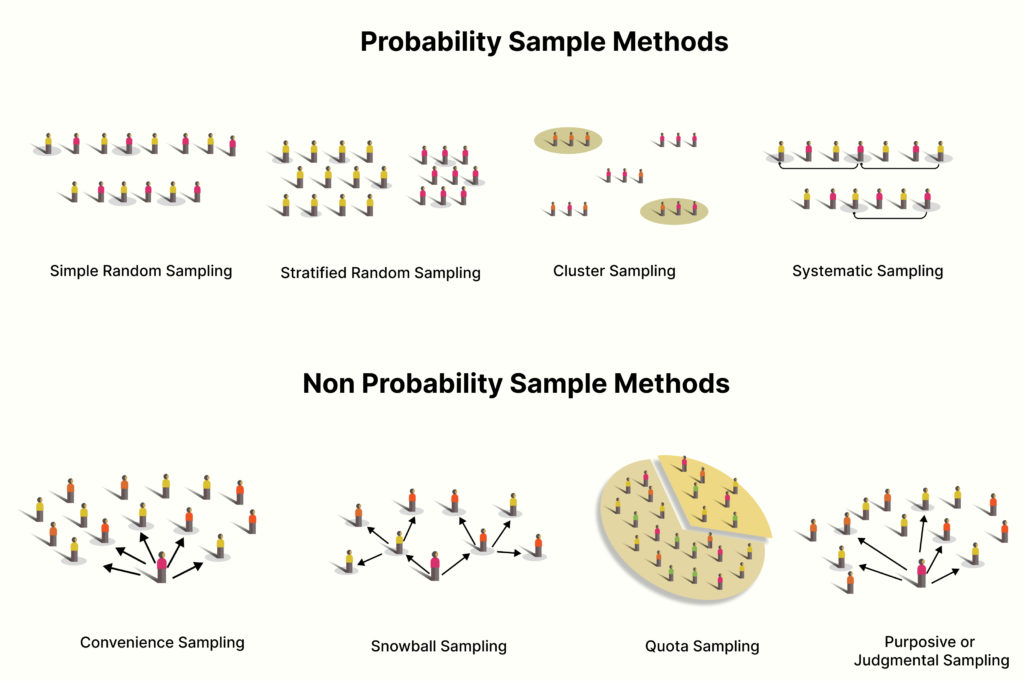
What is Sampling? What are the Types of Sampling Methods?
One of every research project’s most crucial components is the sample chosen to perform the investigation. One who participates in a study is considered a research sample, which allows researchers to investigate vast populations without having to speak with every single member of the community.
The reliability and validity of a study’s findings, or the degree to which those reading the results can have confidence that they will continue to produce the same results over time and that they represent the larger population being studied, depend on the sample source, sample size, and the type of sampling method used to select the sample.
In this series of blog postings, we will describe the many components of a sample in detail, along with the significance of each one. In order to understand the distinctions between a probability sample and a non-probability sample, we will first look at the two types of sampling methods.
Probability vs Non Probability Sampling
The two primary types of sampling are probability sampling and non-probability sampling.
1. Probability Sampling
Respondents are chosen at random to participate in a survey or other kind of study in probability sampling. Every member of the population must have an equal chance of being chosen for the study in this type of sampling, and the researcher must be aware of this probability for the sample to be considered a probability sample.
For public opinion research, election polling, and other studies whose findings will be applied to a larger population, probability sampling is the most popular type of sampling. This is true regardless of whether the larger population is extremely large—such as the whole population of a nation—or small—such as the young women residing in a particular town.
2. Non-Probability Sampling
The creation of a sample through a non-random procedure is known as non-probability sampling. For example, a researcher may stop individuals on the street or email a link to a survey to their acquaintances. This type of sampling would also include any focused studies that purposefully choose participants from certain lists, such as assistance recipients or students enrolled in a particular training program.
Non-probability samples are often used in the exploratory phase of a research study and in qualitative research, which is more individualized than quantitative research, as well as for studies with particular target groups in mind, such as maize farmers.
This type of sampling may, in general, be a more time-and money-efficient method than probability sampling, although this relies on a variety of factors, including the target population being investigated. Certain non-probability sampling techniques may potentially skew the sample and outcomes. Probability sampling is often the preferred approach for broad population studies meant to reflect the total population of a nation or state.
Different Probability Sampling Methods
The category of probability sampling includes various different types of sampling techniques. Everyone in the sample frame for each approach has a chance of being chosen to take part in the research. The following four probability sampling designs are the most popular:
Unlock Unlimited Surveys & Responses with Fynzo Survey – 99% Features Free Forever!
⭐ Rated #1 Trending Survey Tool by Software Suggest ⭐
Why Choose Fynzo Survey?
- Unlimited Surveys: Create as many surveys as you need without any limits.
- Unlimited Responses: Collect unlimited responses effortlessly.
- 99% Free Features: Access nearly all our powerful features for free, forever.
- User-Friendly: Easy setup, create your survey in minutes.
1. Simple Random Sampling
Each person in a population is given an identification, such as a number, and those chosen to be included in the sample are chosen at random, often using an automated software program. This is the simplest type of probability sampling, known as a simple random sample.
2. Stratified Random Sampling
A simple random sample is the simpler version compared to a stratified random sample. In this approach, the population is broken down into sub-groups, such as men and women, and a simple random sample is collected from within each sub-group. This provides a random sample that is representative of a broader population and its particular make-up, such as the population of a nation.
3. Cluster Sampling
A population is separated into clusters in cluster sampling that are distinct but reflect a variety of groups; cities are often used as clusters. A few clusters are randomly chosen to participate in the research from the list of clusters.
4. Systematic Sampling
Participants are chosen to be a part of a sample by utilizing systematic sampling using a set interval. The 5th, 10th, 15th, and 20th names on a list, for instance, may make up the sample if the interval is 5.

Different Non-Probability Sampling Methods
Non-probability sampling involves choosing research participants who have a higher likelihood of being chosen than other members of the population for some reason rather than at random. Various non-probability sample designs include:
1. Convenience Sampling
This type of sampling, as its name suggests, depends on having quick access to research participants. These may be friends, individuals passing by on the street, or students taking a course at a university. While convenience sampling is fast and simple, it does not provide data that can be generalized to a larger population.
2. Snowball Sampling
Snowball sampling operates by enlisting a few sample participants, who then enlist acquaintances of their own to join the sample. This type of sampling is effective for reaching highly niche people who are likely to know others who fulfill the requirements.
3. Quota Sampling
In this type of sampling, a population is segmented into subgroups based on factors like geography or age, and goals are established for the number of responses required from each category. The primary distinction between quota sampling and stratified random sampling is that quota sampling does not use a random sampling approach.
For instance, a researcher could use a convenience sample with predetermined quotas to guarantee that there are equal numbers of men and women included, but this approach would still not give every member of the population a fair chance of being chosen, making it clear that it is not a probability sample.
4. Purposive or Judgmental Sampling
Using this type of sampling method, the researcher chooses the sample based on their understanding of who would meet the study’s eligibility requirements.
For instance, a purposeful sample can consist only of Ph.D. candidates in a certain field. This selection approach may be used to investigate certain traits. Bias may, however, be introduced since the researcher may have an impact on the people who are chosen to participate in the study.
Conclusion
In general, there are a various different types of sampling methods to choose from when organizing your surveys. The ultimate objective is to make your sample as representative of your population as possible so that you may draw inferences and generalize from the data. Results from an inadequate sample will be subpar. After all, as we are all aware, bad data leads to bad outcomes, which are useless to anybody. For better outcomes, use a representative sample.
Unlock Unlimited Surveys & Responses with Fynzo Survey – 99% Features Free Forever!
⭐ Rated #1 Trending Survey Tool by Software Suggest ⭐
Why Choose Fynzo Survey?
- Unlimited Surveys: Create as many surveys as you need without any limits.
- Unlimited Responses: Collect unlimited responses effortlessly.
- 99% Free Features: Access nearly all our powerful features for free, forever.
- User-Friendly: Easy setup, create your survey in minutes.
FAQs
1. What does sampling mean?
In statistical analysis, sampling is the act of selecting a predefined number of observations from a larger population.
2. Why is sampling used?
A technique used to determine how much data should be gathered and how often it should be collected is sampling.







